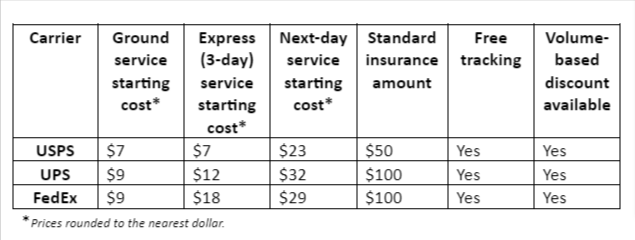Your small business is unique. That’s why it’s important to have a solid shipping strategy that caters to your customers’ needs.
When determining the ideal shipping and fulfillment strategy for your company, it helps to remember that shipping is not just another cost item. It’s an investment in building a better relationship with your customers. And in return for that investment, you have a stronger chance of gaining valuable repeat business.

Fortunately, many cost-effective small business shipping solutions can help you deliver on time and grow your business. But how can you choose the best shipping company and find the best shipping rates?
Below, we walk you through options for the best shipping for small businesses and how to reduce costs while giving your customers the excellent shipping experience they expect.
Shipping Challenges for Small Businesses
For small businesses, it’s challenging to compete with major retailers like Amazon and Walmart. These huge companies have the resources and logistics networks to offer fast, free delivery. They have set a high standard which many shoppers expect all retailers to adhere to.
If you operate a small business, you’re probably familiar with some of these common shipping challenges:
- Managing costs, finding the cheapest rate, and leveraging shipping discounts
- Determining how much to charge for the cost of shipping and what shipping services to offer
- Handling returns and shipping labels
- Dealing with international shipping services
To overcome these challenges, two main strategies can make all the difference:
- Automated shipping
- Multi-carrier shipping
We’ll show you how these strategies benefit your business and help you save time and money. But first, let’s look at which factors contribute to your overall shipping costs to begin with.
Main Shipping Cost Drivers
To figure out where you can lower your shipping costs, it’s important to understand how shipping costs are calculated. Here are the main factors that determine how much you pay to ship your products:
Delivery Speed: How Fast Will Your Customer Receive Their Package?
Up to 60% of consumers say they would wait 5 – 7 days to receive an item if there was free shipping. If you offer express or same-day delivery, chances are you will pay more for shipping. To recoup those costs, you have to charge customers more, but the speed of delivery is not as important to customers as spending less money, according to numerous studies.
By offering free shipping and clearly outlining delivery times, customers are happy to wait. Therefore, consider scrapping same-day or next-day delivery options, which ultimately cost you more.
Size and Weight: What are the Package’s Dimensions? How Heavy is it?
Every carrier has its own specific criteria and terms to describe the weight and size of parcels. In most cases, heavier packages or oversized/large parcels will be subject to additional surcharges.
In terms of weight, packages less than 50 pounds will be charged according to their ‘dimensional weight’ – meaning how much space they take up – rather than how heavy they are. Packages heavier than 50 pounds will be priced according to their weight rather than how much space they take up.
Double-check your invoices to ensure that the right packaging is used. Sometimes carriers determine packaging to be larger than it is and charge you more – and use data analytics to help ensure you are being charged correctly.
Destination: How Far Does the Package Have to Travel?
The further packages travel (or the higher the shipping zone), the higher the shipping costs. It might seem cheaper to pay a few extra dollars to ship a package rather than operate out of multiple locations, but all those additional shipping costs add up.
To better manage shipping expenses, consider shipping from a central location. Shipping shorter distances will also help you leverage ground shipping solutions rather than more expensive options like air freight. A distributed warehouse network ensures that you can ship items from the warehouse closest to your customer, to get faster delivery with the cheapest shipping. Shipping times improve, as does the customer experience.
Shipping Volume: How Many Packages Does Your Company Ship Annually?
Tying in with package destinations, as your order volume increases and you ship from additional locations in different geographic regions, you will reduce handling and shipping costs because orders can automatically be shipped from a facility closest to the shipping destination.
Extra Services: Do You Want Extra Services like Tracking, Insurance, or Flexible Delivery Options?
Extra services cost more. However, it’s possible to find a carrier that offers extras as part of a pricing plan. This helps to cut shipping costs. Rather than paying for tracking and flexible delivery with one company and insurance and other extras with another company, research several different carriers to find one that gives you the most value for money and has a reputation for good customer service.
Here are some important questions to consider when thinking about which cost drivers will affect your shipping:
How Fast Should I Deliver?
In the age of Amazon Prime and same-day delivery, fast shipping has become the norm. And generally, the faster the shipping, the higher the price.
Small businesses often cater to niche markets. This means your customers may be less insistent on fast delivery, as long as they receive a product they can’t get anywhere else.
Still, it is important to take consumer preferences into account when deciding what delivery speed you should offer:
- Standard shipping is generally considered 3 to 5 working days.
- It is also a good idea to offer expedited service for customers who want to receive their order even faster.
How Does My Shipping Volume Affect Costs?
The more you ship, the more power you have to negotiate better shipping rates with carriers. If you ship a large enough volume, you will often be eligible to receive volume-based discounts from your carrier.
Yet, it may be difficult for small businesses to reach the minimum volumes. For example, USPS (First Class/Priority/Express) requires a minimum of 5,000 parcels in the previous year for a volume-based discount.
Still, there are other ways for small business owners to secure shipping discounts (see “Ways of reducing costs” below).
What if I Need to Ship Internationally?
International shipping is a great way to grow your business. There are a few important things to keep in mind, though:
- Import restrictions may apply for some products, such as alcohol or hazardous items.
- Customs fees may apply, and it is important to communicate this to your customer in advance to avoid unpleasant surprises.
- Transparency is always the best approach. Always be clear and up-front about international shipping costs. Include your international shipping rates clearly in your shipping policy information.
How Much Should I Charge for Shipping?
In terms of how you pass shipping costs onto your customers, you have a few options to consider:
Free Shipping
Everyone loves free shipping, but for small businesses, it often cuts too deeply into your margin. Fortunately, many shoppers who buy from small businesses do not necessarily expect free shipping.
If universal free shipping is not an option for your business, you might consider offering a free-shipping threshold (for example, free shipping on orders above $100).
Flat-rate Shipping
Flat-rate shipping is an attractive option for small businesses, especially if your parcels are usually around the same size and weight.
Start by calculating the average amount that you pay for shipping per order. You can then charge that amount to all your customers. Be sure to display the flat shipping rate clearly on your website, so customers know how much the shipping costs before they check out.
If a customer places a large order, the actual shipping costs may be higher than the rate they pay. But you can consider this a gift to a customer who has spent a lot in your shop.
And customers who place smaller orders may overpay for shipping, which means the costs roughly balance out.
Which Extra Shipping Services Should I Offer?
You can offer many additional shipping-related services to give your customers a better shipping experience. Here are a few to consider:
- Tracking: Customers love tracking the status of their package once it’s been shipped.
- Insurance: Most major carriers include insurance as standard (see the comparison of carriers below). If you sell high-value merchandise, you may consider buying additional shipping insurance.
- Flexible delivery: Many customers enjoy the flexibility of choosing their own delivery date or redirecting a package that is already in transit.
Choosing services like these depends entirely on your customers’ preferences, the price they (and you) are willing to pay, and the type of merchandise you sell.
Ways of Reducing Costs
You can take many steps to lower your shipping costs as a small business owner. These include:
- Automating shipping processes
- Securing volume-based discounts
- Securing other discounts
- Taking advantage of real-time rate fluctuations
- Lowering your return shipping rate
- Use flat-rate packaging
Automating Shipping Processes
Shipping software enables you to save time and money by automating tasks like generating shipping labels, selecting the cheapest carrier based on an order’s specifications, or automatically notifying customers of their shipping status.
Volume-Based Discounts
As mentioned above, if you ship a large enough volume, you can negotiate with your carrier for a volume-based discount. But another option is to work with a shipping platform like Sendcloud, which gives you access to even more volume-based discounts.
Teaming up with a shipping platform is advantageous for small businesses because it enables you to secure volume-based discounts that you would not have access to on your own.
Other Discounts
Most major carriers, including UPS and FedEx, offer loyalty programs that entitle you to discounts. Some carrier loyalty programs may entail a minimum order or an obligation for you to use one specific carrier exclusively.
UPS and FedEx also offer discounts to retailers who sell via certain third-party logistics (3PL) partners, such as the Walmart Marketplace.
Real-time Rate Changes
When shipping rates change due to fluctuations in the market, peak-period pricing, or other factors, you can save money by automatically switching to the cheapest carrier. This is another great advantage of using a shipping platform or automated shipping software in your shop.
Lowering Your Return Shipping Rate
Return shipping is a major expense. But you can minimize the risk of returns by optimizing your product pages. Ensure that your product descriptions are highly detailed and include plenty of photos and videos showing the product in action. This ensures that the customer knows exactly what they’re buying, reducing the risk of returning it.
Use Flat-Rate Packaging
All major carriers offer flat-rate packaging, which you can use to ship your merchandise as a small business owner. These are prepaid packages of a standard size that you order in bulk from the carrier. Simply package your products inside the flat-rate box, and you’re ready to ship. Just remember that weight restrictions may apply.
Best Shipping Methods for Small Businesses
So, now that we’ve covered the most important shipping strategy topics, you’re probably wondering: What’s the best way to ship for small businesses?
The biggest shipping trend for small businesses in recent years is multi-carrier shipping.
What is Multi-Carrier Shipping?
With a multi-carrier strategy, you can ship using a selection of different carriers instead of just one.
The truth is: Even for small businesses, it’s important to have a selection of multiple carriers that you can rely on.
If you place all your shipping volume with a single carrier, you will inevitably run into a bottleneck at some point.
Multiple carriers at your disposal allow you to react with greater speed and flexibility in case one carrier is overloaded or unable to offer you the service level you need for whatever reason.
Combined with the right shipping software, a multi-carrier shipping strategy is ideal for small businesses. It lets you manage your costs effectively while providing a flexible, customer-friendly shipping experience.
How Does Multi-Carrier Shipping Work?
In the old days, if you wanted to work with multiple carriers, you’d have to integrate each separately in your shop software. This is a time-consuming and difficult task.
Modern shipping platforms for ecommerce are designed to accommodate the multi-carrier strategy. They let you integrate multiple carriers all at once into your shop.
They also let you set rules for which carrier to use for each order (for example, ‘Use USPS for domestic shipping’ and ‘Use DHL for international shipping’).
Best Shipping Carriers for Small Businesses
So, what is the best shipping company for small businesses to use? Well, the answer is: all of them. Each carrier offers its own pros and cons. And as mentioned above, it’s wise to include a selection of different carriers as part of your own multi-carrier strategy.
Below, you’ll find a comparison of the most popular carriers and the services they can offer you.

Overall:
- For parcels up to 1 pound (16 ounces) in weight, USPS First Class Mail offers the best rates.
- USPS Priority Mail often offers the best rates for parcels up to 10 pounds. Flat-rate service from USPS Priority Mail is particularly attractive for small businesses.
Fast, Flexible and Customer-Friendly
Now you know the ins and outs of designing a smart shipping strategy. You’re all set to find the best shipping rates for your small business.
To summarize:
- Free shipping is a crowd-pleaser, but it’s not a requirement. You can still stand out from competitors by offering excellent service and unique quality.
- Consider a free-shipping threshold or flat-rate shipping if free shipping is not an option for your business.
- Using shipping software to automate shipping lowers costs because it lets you choose from multiple carriers and take advantage of volume discounts and real-time rate changes.
- A multi-carrier strategy is an ideal way to ensure the fastest, most flexible shipping, all the time.







